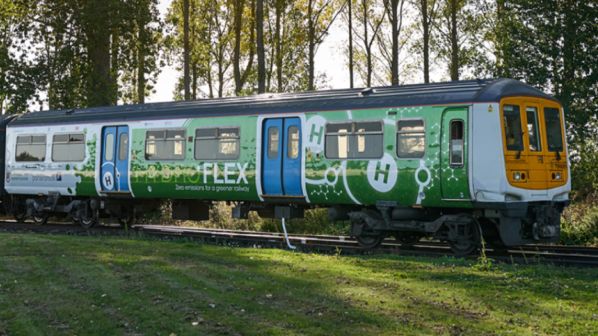The winning projects fall into four categories: customer experience, environmental sustainability, maintenance, and train operation.
“I am delighted to announce the winners of this year’s FOAK competition, which will support better, more environmentally friendly journeys,” says Britain’s transport secretary, Mr Grant Shapps. “Crucially, these pioneering projects will also ensure that passengers have a more efficient, reliable and responsive railway, making their journeys simpler and easier.
“From clever technology on platforms to prevent icy surfaces, new ‘seat-switching’ apps and improved 5G Wi-Fi connections, harnessing innovation will be crucial to modernising the network and making our railways greener and cleaner, as we build beyond coronavirus and look to the future.”
“These high-quality projects illustrate the appetite of UK organisations to develop new and exciting innovations for rail transport that improve customers’ user experience, optimise railway efficiency, and are environmentally sustainable,” says Mr Ian Campbell, executive chair of Innovate UK.
The 25 projects comprise:
Customer experience
Train swap, Seatfrog Ops: allows passengers to update their seat reservation quickly and remotely.
Dynamic capacity management, Esoterix Systems: introduces utility-style ticketing that adjusts to travel patterns and rewards particular choices, using a monthly subscription that will help passengers save money on a large upfront fee.
Next-generation composite poles for a 5G railway, Hive Composites: installation of lineside lightweight composite poles to improve Wi-Fi speed, consistency and connection for all rail passengers.
Illumin-heated concrete platform copping slabs, Sheffield Hallam University: illuminated and heated low-energy concrete slabs for station platforms that automatically switch on in freezing conditions to help prevent passengers slipping on ice.
Laminar, iProov: demonstrates how biometrics can dramatically enhance the passenger experience, reduce congestion, improve safety and enhance security.
Track to train communications for Transport for Wales, Ingram Networks: lab-based study into new very high-speed communications technology for railways demonstrating very cost-effective track to train communications infrastructure on an 8km heritage railway in Leicestershire, at speeds of more than 10Gbps.
Environmental sustainability
Trac Rail Transposer (TRT-e), Unipart Rail: a prototype zero-emissions machine that removes and replaces rails.
LoCe - less oil and cleaner exhaust, Porterbrook Leasing: transferring novel retrofit technology onto a class 170 DMU to make mid-life diesel engines more environmentally sustainable.
Zero-emission rail freight power, Steamology Motion: a hydrogen-based steam turbine that delivers zero-emission power solutions for existing freight locomotives.
Daybreak, Riding Sunbeams: focuses on decarbonisating the rail industry through a direct connection between renewable energy generation and overhead electrification.
Resi-Glaze, Far-UK: a resilient glazing solution to improve passenger safety on trains with potential CO2 emissions saving.
HydroFlex raft production, BCRRE: a hydrogen train power pack designed to minimise the loss of passenger saloon space.
Composite footbridge, Associated Utility Supplies: the first railway footbridge made entirely from fibre reinforced polymer, making it significantly easier to install than a steel footbridge, greatly reducing network disruption and local environmental damage.
Maintenance
Integrated optical fibre sensing (OptRail-Pro), RCM2: optical fibre sensors that monitor the condition of switches and crossings.
Train axle crack monitoring, Tamon - Perpetuum: sensors and pattern-recognition technologies to monitor for cracks in train axles.
High-speed cryogenic blasting, The University of Sheffield: high-speed cryogenic cleaning system for tracks to prevent low adhesion and slow running of trains.
InnoTamp, Fugro: data gathering to ensure the maintenance of optimum rail alignment.
Thermal radiometry for the remote condition monitoring of rail vehicles, Rail Innovations: uses a thermal radiometry camera technology to measure temperatures of mechanical systems on moving trains to allow automatic alarms to be sent over the internet in the event of an over-temperature occurrence.
Train operation
Minimising disruption of overhead line renewals via novel head-span assemblies, Associated Utility Supplies: span wire clamping system to enable rapid, low-cost overhead line equipment head-span renewals with minimum network disruption.
Trainserv software user trial and preparation for commercialisation, Cogitare: Trainserv integrates multiple sources of real-time data for use by rail workers to help them improve services and respond to incidents.
Cleartrak on-train testing (CoTT), Garrandale: innovative system for processing toilet waste, reducing cost and maintenance requirements.
Iris information system for station staff, Liverpool John Moores University: a new type of information system for station staff to enhance communication and enable them to help passengers in making travel decisions.
Railway optical detection and obstructions - tunnel and station monitoring, Vortex IoT: sensors and data analysis tools to detect and identify intrusion and obstructions on the track and send real-time alerts to the control centre to prompt further investigation.
Improving resilience through a surface water flooding decision support system, JBA Consulting: a first-of-a-kind surface water flood forecasting and early warning system for Network Rail using technology and data to map the surface water flood likelihood in real-time ahead of the event.
Improved railway operation through train-mounted water addition, CoCatalyst: spraying a small amount of water from the train when slippery rails are detected to improve adhesion and braking.

